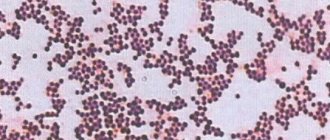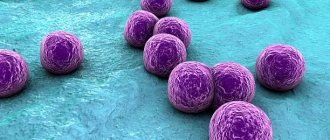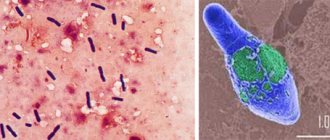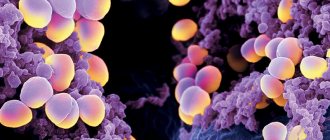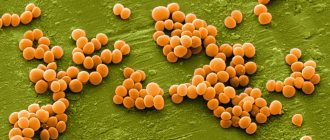Home / Articles / Staphylococcus aureus in the nose: is treatment necessary?
Staphylococcus aureus is a pathogenic microorganism, the carriers of which are about 30-40% of people. Infection occurs through airborne droplets and household contact, through the birth canal and breast milk.
The bacterium can “live” on the mucous membranes of the nose, throat, intestines and stomach, and on the skin. With a decrease in immunity, stress, injury and damage to the mucous membranes and epidermis, cocci begin to actively multiply, provoking a chronic inflammatory process. If it develops in the nasopharynx, nasopharyngitis, tonsillitis, and adenoiditis are diagnosed. If the skin is damaged - acne, boils, abscesses. In young children, the bacterium often affects the gastrointestinal tract, leading to colitis, dysbacteriosis, and digestive disorders. Staphylococcus aureus quickly penetrates other parts of the body. Without treatment, it can lead to purulent abscesses of internal organs, meningitis, pneumonia, and sepsis.
Symptoms of staphylococcus in the nose
In some cases, a person may not be aware that one or another type of staphylococcus lives in his nose. This is asymptomatic carriage. But in the presence of a number of predisposing factors, for example, with a decrease in immune strength, with exacerbation of chronic diseases, with hypothermia, with injuries to the nose and for other reasons, the bacterium begins to actively grow and multiply. In some people, pathogenic staphylococcus immediately after contact with the nasal mucosa causes inflammation.
This leads to the appearance of a characteristic clinical picture:
- The appearance of a runny nose, which in medicine is called rhinitis.
- An increase in mucous secretion, which is initially transparent, but after a short time impurities of pus are found in it.
- Difficulty breathing due to blockage of the nasal passages.
- Violations of the sense of smell, inability to fully perceive odors.
- Changes in the timbre of the voice, its nasality and hoarseness.
- Breathing through the mouth, which is fraught with the development of complications in the form of inflammation of the larynx, trachea and bronchi.
- Increased body temperature; in acute rhinitis it can reach 38 °C. If complications develop – 39 °C or more.
- Disturbances in night rest, difficulty falling asleep, general fatigue and malaise.
- Often, staphylococcus, in addition to the nasal cavity, colonizes the paranasal sinuses, provoking the development of sinusitis or sinusitis.
- Children may have a rash on their body.
How does a staphylococcal infection manifest?
Symptoms, its duration and intensity depend on the strain of the pathogen, the general physical condition of the patient and the characteristics of his immunity. Two characteristic signs of staphylococcal damage: inflammation of various localizations and intoxication.
With pyoderma, the sweat, sebaceous glands, and hair follicles become inflamed, causing painful convex nodules that fill with pus to form on the skin. Boils and carbuncles are usually surrounded by areas of red, swollen skin. With intense inflammation, fever and swelling of the lymph nodes located close to the sites of inflammation are likely.
Infection of the nasal sinuses by staphylococcus is manifested by a common runny nose with viscous yellowish or green discharge. Penetration of infection deeper causes the development of sinusitis. Their symptoms are typical:
- congestion in the bridge of the nose;
- feeling of heaviness, fullness on the affected side;
- labored breathing;
- thick purulent discharge from the nose;
- increase in body temperature above +37°C.
Often the infection spreads to the middle ear, causing otitis media: sharp shooting pains, hearing loss. When the mucous membranes of the eyes are damaged, suppuration of the conjunctiva develops, the sclera turns red and swells.
When staphylococcus attacks the upper respiratory tract, purulent pharyngitis or laryngitis is inevitable. Their signs:
- hoarse voice;
- severe swelling, redness of the throat;
- difficult painful swallowing;
- dry obsessive cough, discomfort in the throat.
Staphylococcal pharyngitis often affects children under 12 years of age. In adults, this pathology is controlled by the immune system.
With the development of inflammation in the lower parts of the respiratory tract, bronchitis and pneumonia are “relevant” with a characteristic barking or wet cough, high fever and physical weakness.
Less common signs of staphylococcus infections:
- food poisoning;
- inflammation of joint tissues, muscles;
- cardiac dysfunction.
Among the serious complications caused by staphylococcus are: meningitis, lung abscesses, osteomyelitis, toxic shock syndrome, generalized sepsis.
How is staphylococcus transmitted in the nose?
To avoid infection, it is worth knowing how bacteria can enter the nasal cavity.
Among the most common methods of transmission, doctors have identified the following:
- Airborne path. That is, a person inhales air that is contaminated with staphylococcus and they naturally enter the cavity of his nose, resulting in infection. They are released into the environment by human carriers when sneezing, coughing and talking. In addition, pets can serve as a source.
- The period of intrauterine development, the process of childbirth and breastfeeding. Children becoming ill with staphylococcal infections are almost always associated with the fact that their mother is infected. The fetus can become infected hematogenously, as well as due to placenta adherens and other labor disorders.
- Airborne dust path. This route of infection is closely related to the airborne route. That is, when an infected organism releases bacteria into the environment, they, in turn, do not immediately reach the nasal mucosa, but settle in the dust. A healthy person becomes infected when they inhale this dust.
- Contact and household route of infection. When infection occurs as a result of using someone else's personal hygiene products or through close contact, for example, a kiss or simply touching the skin.
- Infection in a hospital setting.
In addition, there are additional risks that contribute to the fact that the bacteria enters the nasal cavity and begins to actively multiply there:
- Hypothermia is one of the leading provoking factors of inflammation. This is explained by the fact that when a person inhales cold air, the cilia of the ciliated epithelium, which are responsible for cleansing the nasal cavity, stop actively moving. As a result, pathogenic microbes settle in the mucous membrane for a long time and begin to actively multiply there.
- ARVI and influenza no less often lead to the development of staphylococcal rhinitis. Against the background of these diseases, not only local, but also general immunity decreases. Therefore, the infection often awakens precisely during an acute respiratory illness.
- Prolonged use of drops that have the property of constricting blood vessels leads to the fact that a person begins to suffer from drug-induced rhinitis. Against this background, it is much easier for staphylococcus to penetrate inside the nasal cavity and begin to multiply.
- State of health and age of the person. There are certain groups of people who are most susceptible to staph infections. These groups include children under one year old, newborns, the elderly and people with serious chronic diseases.
- The body's susceptibility to bacteria increases due to long-term use of medications, for example, cytostatics and corticosteroids.
- Exacerbation of chronic foci of infection - tonsillitis, adenoiditis, pharyngitis.
- Severe and prolonged stress.
Prevention of staphylococcus
To prevent infections associated with staphylococcus, it is recommended:
- washing hands before eating and after going outside;
- treating any cuts, abrasions and wounds with antiseptics;
- strengthening the immune system through hardening, proper nutrition and exercise.
“SM-Doctor” is a clinic where real professionals work. If you detect the slightest signs of infectious processes in a child, you should immediately seek help. Timely initiation of proper treatment is the key to the health and well-being of every child. Contact us!
Why is staphylococcus in the nose dangerous?
The danger that an inflammatory reaction caused by a staphylococcal infection occurs in the nose is that the process can quickly spread not only to the respiratory tract, but also to neighboring organs. That is, not only the nearby nasal sinuses, trachea, larynx or tonsils can be affected. By hematogenous or lymphogenous route, the bacterium is able to reach the lungs, liver, heart, etc.
The following clinical picture is often observed: a patient who suffered only from a runny nose, after a few days, in the absence of treatment, begins to notice signs of otitis, tonsillitis, sinusitis, adenoiditis, etc. In addition, in a certain category of people with a predisposition, the bacterium in within a few days it can cause bronchitis and tracheitis. And the beginning is a seemingly banal acute rhinitis.
Staphylococcal infection in the nose is extremely dangerous for children and the elderly. In them, the bacterium can provoke not only bronchitis and tracheitis, but also abscesses, massive lesions of the lungs, bones, brain, kidneys and heart. In the most difficult cases, the presence of staphylococcus in the nose can lead to septic blood poisoning.
That is why the detection of staphylococcal infection in newborn children is a reason for inpatient treatment.
Treatment of staphylococcus
Treatment of staphylococcal infection is always individual and depends on the characteristics of each specific case.
SM-Doctor doctors have more than 10 years of experience working with such patients and know what remedies need to be used in each case. The clinic applies diagnostic and treatment standards approved by the global community of doctors. To combat the pathogen, the following are traditionally used:
- antibiotics (penicillins, cephalosporins, fluoroquinolones). Depending on the location of the pathological focus, the doctor may prescribe a remedy in the form of ointments, tablets, injections;
- antipyretic medications (paracetamol, ibuprofen) to combat fever above 38°C;
- local antiseptics (“zelenka”, hydrogen peroxide, furatsilin).
Staphylococcus aureus in the nose
It is the mucous membrane of the nasal cavity that is the favorite place of settlement for Staphylococcus aureus. Often it exists there for a long time asymptomatically, but in the presence of factors such as hypothermia, infection with acute respiratory viral infections, and the use of vasoconstrictor drops for a long time, it begins to actively multiply, causing acute rhinitis.
In the future, acute rhinitis causes serious complications, which were described above. Another danger of Staphylococcus aureus is its low susceptibility to penicillin drugs. That is, in order to select adequate therapy, it is necessary to conduct an antibiogram.
Prospects
Due to the high effectiveness of lugdunin, the authors of the work discussed suggest using S. lugdunensis in the fight against Staphylococcus aureus, especially in patients with a high risk of developing infection - after surgery, immunosuppression or hemodialysis. Previously, probiotics were usually called bacteria that actively act for the benefit of the macroorganism in the gastrointestinal tract. Zipperer's group advocates expanding the concept of "probiotics" to include bacteria that fight infections in other places in the human body, such as the nasal cavity or skin.
In very rare cases, S. lugdunensis itself can cause diseases, but if it is possible to create mutants that completely lose virulence factors, or to integrate the lug operon into absolutely “peaceful” bacteria, a safe probiotic preparation can be developed.
Lugdunin was the first discovered bacteriocin of a new class - macrocyclic thiazolidine peptide antibiotics. All tested strains of S. aureus (both natural and laboratory) were unable to develop resistance to it. This gives hope that lugdunin will become a commercial drug against Staphylococcus aureus in the future.
And finally, the very fact of the discovery of a new antibiotic in a representative of the human microbiota should serve as an incentive to intensify the search for other bacteriocin producers within just such communities. In the future, this will help doctors more successfully contain the onset of multi-resistant pathogens.
Diagnostics
Before starting treatment, it is necessary to conduct a high-quality diagnosis. The main analysis that is used in medical practice when the presence of a pathogenic bacteria is suspected is their isolation using bacterial culture. However, the patient will need to prepare for the study in order to obtain the most reliable result.
Firstly, you should stop using any nasal drops on this day. Secondly, do not undergo treatment with any antibacterial agents for at least a week. The only drawback of this method is that you will have to wait at least five days for the results.
If the diagnosis needs to be made faster, then the microscopic method of smear analysis comes to the rescue. But in contrast to this, the cultural method of research, namely bacterial culture, will not only clarify the data obtained, but also identify a specific type of bacterium, and also supplement the information with an antibiogram.
After the results have been received and staphylococci have been detected in the nose in an amount exceeding the maximum mark of 106 units, it is necessary to begin treatment.
Classification of infection
In medicine, there are two forms of staphylococcal infection - generalized and focal. In the first case, we are talking about sepsis, when all systems and organs are infected with staphylococcus. Sepsis is a dangerous condition that often ends in death even with qualified medical care.
More often, a focal form of staphylococcal infection is diagnosed when diseases of the skin, bone tissue, and joints are detected. Separately, doctors identify food poisoning with toxins - with characteristic symptoms of Staphylococcus aureus in the intestines of adults.
Staphylococcal infection can occur in mild, moderate and severe, acute or chronic form.
Symptoms of infection
Signs of food poisoning begin to appear within hours of eating contaminated food, as toxins are released in the stomach and intestines. The main symptoms are associated with the influence of toxins on the walls of the gastrointestinal organs, which causes dysfunction of the digestive system.
The most common symptoms and signs:
- Nausea and profuse vomiting.
- Watery or bloody diarrhea.
- Abdominal pain and cramps.
- Fever.
- Headache.
- Muscle pain.
- Dehydration, manifested by decreased blood pressure, weakness and dizziness.
It is important to consult a doctor if the following symptoms occur:
- Continuous vomiting, preventing you from eating or drinking water.
- Bloody vomiting.
- Blood in the stool.
- Severe intestinal cramps.
- Temperature above 38°C.
- Dry mouth, weakness and dizziness.
Symptoms of poisoning usually go away on their own after a few days, but complications are possible. The main danger is associated with significant loss of fluid by the body due to the fact that toxins interfere with the absorption of water in the intestines.
Severe dehydration can cause death if poisoned.
When colonization is determined by just a few villi
In particular, some types of Lactobacillus casei (a species of lactobacilli) found in the noses of healthy people were found to have many villi, allowing them to adhere firmly to the nasal walls. Like Spiderman climbing a building, these specific lactobacilli can move through our nasal cavity even “against the wind” (sneezing) and “rain” (runny nose). Once in place, L. casei suppresses infectious agents by preventing them from settling in an already occupied area and inhibiting their growth through the lactic acid it produces.


